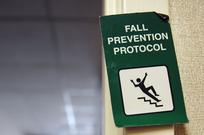Source: American Academy of Orthopaedic Surgeons
 That’s what a study in the Journal of the American Academy of Orthopaedic Surgeons suggests. Despite nationwide efforts to prevent inpatient falls, hospitals do not prevent a significant amount of falling in hospitals. Falling is the leading cause of injuries (fatal and nonfatal) for older Americans. 1 in 3 senior citizens have fallen, totaling more than 11 million people over the age of 65, according to the AAOS press release accompanying the article.
That’s what a study in the Journal of the American Academy of Orthopaedic Surgeons suggests. Despite nationwide efforts to prevent inpatient falls, hospitals do not prevent a significant amount of falling in hospitals. Falling is the leading cause of injuries (fatal and nonfatal) for older Americans. 1 in 3 senior citizens have fallen, totaling more than 11 million people over the age of 65, according to the AAOS press release accompanying the article.
In hospitals, about 3%-20% of inpatients have falls. These falls are considered “preventable” by the US Centers for Medicare & Medicaid, and therefore healthcare facilities are held accountable for the costs of treating any resulting injuries. Hospitals appear unable to prevent most falls. Falling-related injuries can have serious results:
- 20% of falls require medical attention;
- Falls can be fatal, or can cause a decline in a person’s health that eventually leads to death or disability;
- Most patients with hip fractures (a common fall-related injury) are hospitalized for about one week; after they are discharged, up to one in four adults who lived independently before their hip fracture has to stay in a nursing home for at least a year after their injury; and
- Treatment of the injuries and complications associated with these falls costs the United States $20.2 billion annually.
Long-standing fall prevention strategies, such as patient education, vision assessment, and walking aids are not as effective in the hospital setting as they are in long-term care or home care settings, according to researchers.
“Of course, hospitals should educate patients and the families, use bed rails, keep beds low, keep floors dry and clear of clutter–all the common sense things that can reduce the risk of falls,” said Terry A. Clyburn, MD, orthopaedic surgeon at the University of Texas Medical School in Houston and the co-author of the article. “But we found no proof that falls in hospital are, in fact, preventable. And if not, they should not be categorized as a preventable occurrence and the burden shouldn’t be borne by hospitals.”
The authors stress the “other contributing factors to falls” as evidence that they are not preventable (from the hospital’s perspective) such as delirium, Parkinson’s disease, osteoporosis or arthritis, stroke, vision or hearing problems, malnutrition, dizziness and vertigo and medications that might alter mental status. Why closer monitoring or additional precautions for these patients could not be implemented is unclear.
The authors conclude that the risk of fall is only “slightly” greater in the hospital environment than in the home and that there is no medical evidence that evidence-based guidelines are effective in fall prevention. (All of which suggests that revisions to fall prevention guidelines may be appropriate).
Post: Gayle R. Lewis, Esquire
